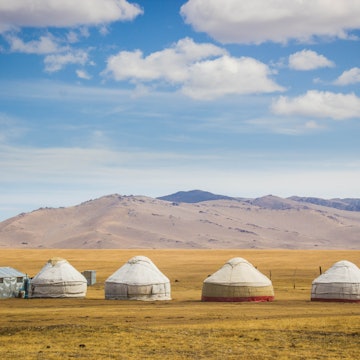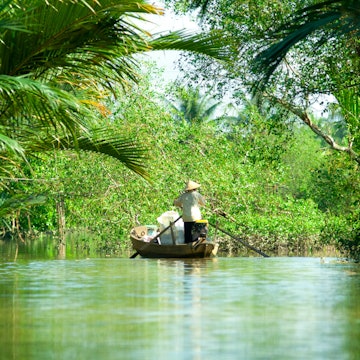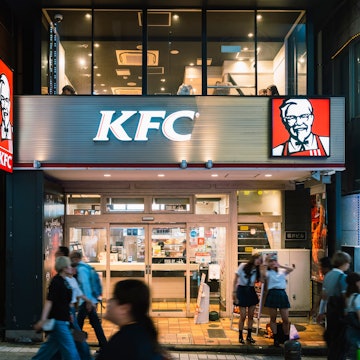

Dim sum: siu mai at Yu Yue Heen Restaurant © Cathy Adams / Lonely Planet
China’s third-biggest city, Guangzhou is the beating heart of the megalopolis that is the Pearl River Delta. This location along the South China Sea has long made Guangzhou one of China's most important trading ports with a colonial background and culturally diverse society.
But as the region’s population has swelled (around 130 million now call the Pearl River Delta home), so has Guangzhou’s profile.

Today, the capital of Guangdong province, formerly known as Canton, has found firm footing as a booming metropolis full of cutting-edge architecture, tasty Cantonese food and plenty of interesting pockets to explore. Interestingly, Guangzhou is also one of the only cities in China where Mandarin and Cantonese are spoken almost interchangeably.
Here are 10 things you can’t miss in Guangzhou.
Guangzhou Opera House
The most striking piece of architecture in town is the eye-popping Guangzhou Opera House, designed by Zaha Hadid. The performance space has Hadid’s signature flowing curves, which according to the architect were inspired by two rocks washed away from the Pearl River. The opera house, which opened in 2010, is just as futuristic looking on the inside as it is on the outside; performances span everything from classical scores to Cantonese operas.

Cantonese food
Guangzhou, long the spiritual home of Cantonese food, is also one of China’s tastiest cities – a status that’s about to become official with the launch of a Michelin Guide to the city later this year. As you would expect from a cosmopolitan centre, Guangzhou has its fair share of premium restaurants, but there’s a pulsing local food scene, too. Explore it with Eating Adventures, which runs half-day foodie tours around Liwan, the city’s traditional quarter. The highlight is the Huangsha Seafood Market, one of the biggest fish markets in southern China, where restaurants in the market building will cook the seafood you’ve just bought downstairs.
Xiaobei
A high level of migration from Africa has made Guangzhou one of China’s most diverse cities. The Xiaobei neighbourhood, which coalesces around Baohan Straight Street, is home to a large concentration of African residents, as well as Uyghurs from northwestern China. It’s an interesting neighbourhood to explore – alongside wholesale markets, you can find some of the city’s best Uyghur food (think hand-pulled noodles and charcoal-roasted lamb) in eateries.

Liwan
The city’s traditional heart is Liwan, the old quarter, where the houses aren’t more than a few storeys tall and Cantonese is still the dominant language. Visit the Qingping Chinese Medicine Market and wander through the streets to find hawkers sitting on plastic chairs, sometimes flogging handfuls of insects and often playing drawn-out games of mahjong. Shangxiajiu Pedestrian Street, the first of its kind in Guangzhou, comes with an odd mix of ear-splitting music and traditional shophouses with a faintly European flair.
Xiaogang Park
Daily life in China is lived out in public spaces like parks. Sprawling Xiaogang Park, in southern Guangzhou, is the ideal place for a lazy weekend stroll – particularly around the lake at its centre. There’s an excellent vegetarian restaurant, Bingsheng Zen Tea House, right by the entrance, which is perfect for a long lunch.

Canton Tower
The city’s tallest structure, the slender Canton Tower, has become the de facto landmark of modern Guangzhou – recognisable for its twisty shape that lights up in a rainbow of colours at night. The viewing platform, at 488m up, offers a breathtaking panorama across Guangzhou and the ultra-modern Zhujiang New Town neighbourhood. Kick the experience up a gear by taking a bubble tram: these clear plexiglass cabins wind slowly around the top of the tower on a track.
Sun Yat-sen Memorial Hall
At the southern end of Yuexiu Park is the imposing Sun Yat-sen Memorial Hall, which commemorates the first leader of modern China. The eponymous doctor, who was born in northern Guangdong in 1866, is immortalised in bronze outside the commanding octagon-shaped hall, which seats more than 3000 people for performances. Also on the Sun trail, a few stops up on metro line 2, you can visit the Sun Yatsen Memorial Museum at the residence where Sun lived during the 1920s.

Shamian Island
This 300-sq-metre island, a former European concession, is one of the prettiest sections of Guangzhou. There are cobbled streets, banyan tree-flanked avenues and wrought-iron signposts – a total contrast to the rest of the city. The Starbucks here, in an old colonial mansion, must rank as one of the most charming branches in the world, while the lobby of the five-star White Swan Hotel is worth a look for its over-the-top pond and mini-waterfall.
Shopping
If you want a snapshot of a very modern Guangzhou, visit Beijing Road – a buzzy, busy and booming pedestrian street packed with hawker stalls and what feels like the entire city population at all points of the day. A more refined shopping experience can be found in Tianhe, a fast-gentrifying business district that’s popular with Hong Kong weekenders (it’s handily near the main Guangzhou East train station). The Taikoo Hui shopping centre is a far calmer retail experience, name-checking over 180 big brands. For browsing antiques of the genuine and not-so-genuine variety, hit up Xiguan Antique Street.

Dim sum
The tradition of yum cha (literally ‘to take tea’) is taken very seriously in Guangzhou, and there are numerous restaurants claiming to have the best selection of traditional dim sum (the small dishes eaten at yum cha). Some claim the best spot in town is Liwan’s Dian Dou De (587 Longjin Zhonglu) – also on the Eating Adventures tour – which serves (arguably) the best egg tarts you’ll find outside of Portugal. For a more formalised affair, there’s the Lai Wan Market, a dim sum restaurant (with tables tucked into traditional sampans) inside the concrete heifer that is the Garden Hotel. Lastly, there’s traditional ‘garden restaurant’ Panxi, a warren of banquet halls set around a gorgeous garden, serving steaming baskets of classic dumplings and bao buns.













